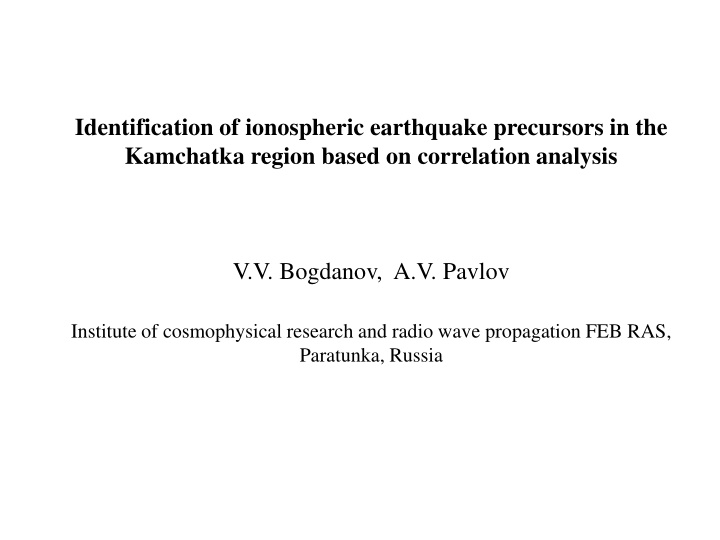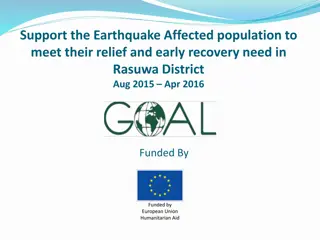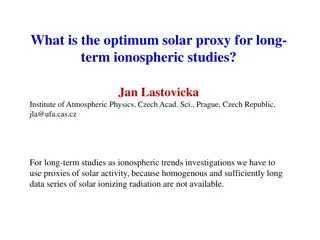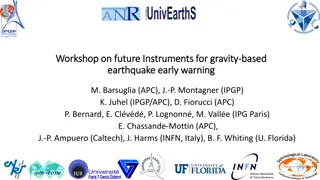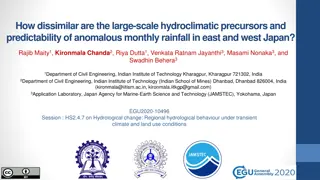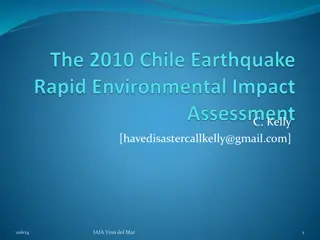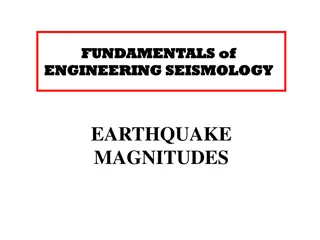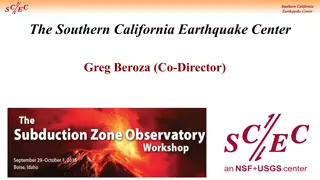Identification of Ionospheric Earthquake Precursors in Kamchatka
Investigating ionospheric variations preceding strong earthquakes in the Kamchatka region using correlation analysis. Method based on electron concentration changes in the ionosphere. Two ionospheric stations, PK553 and EA653, located in different geographic areas are analyzed for correlation coefficients between critical frequencies. Results show potential for using ionospheric data as earthquake precursors.
Download Presentation

Please find below an Image/Link to download the presentation.
The content on the website is provided AS IS for your information and personal use only. It may not be sold, licensed, or shared on other websites without obtaining consent from the author.If you encounter any issues during the download, it is possible that the publisher has removed the file from their server.
You are allowed to download the files provided on this website for personal or commercial use, subject to the condition that they are used lawfully. All files are the property of their respective owners.
The content on the website is provided AS IS for your information and personal use only. It may not be sold, licensed, or shared on other websites without obtaining consent from the author.
E N D
Presentation Transcript
Identification of ionospheric earthquake precursors in the Kamchatka region based on correlation analysis V.V. Bogdanov, A.V. Pavlov Institute of cosmophysical research and radio wave propagation FEB RAS, Paratunka, Russia
Seismic activity is one of the sources of ionospheric variability. In this work, on the basis of the method [Pulinets et al, 2004], the change in the concentration of electrons in the ionosphere, preceding the onset of strong earthquakes with M 6.0 in the Kamchatka region, is investigated. This method is based on calculating the correlation coefficient between the values of the critical frequency foF2 of two ionospheric stations, one of which is located inside the earthquake preparation zone, and the other is outside it. If the observation points are located in similar geographic conditions, then they will also observe the same ionospheric variations in both calm and disturbed geomagnetic conditions, except for those points that are located in the seismically active zone. Local anomalies in the F2 layer accompanying the preparation of strong earthquakes should manifest themselves in a decrease in the mutual correlation of the critical frequencies foF2 between stations located inside and outside the seismic zone. correlation coefficient of critical frequencies hourly values of both stations. maximum and minimum difference of critical frequencies hourly values of both stations. 2
The first station (receiver-sensor) PETROPAVLOVSK (PK553) is located on the Kamchatka Peninsula at the point with coordinates (52.97 N, 158.24 E). The second station ( control receiver ) - EARECKSON (EA653) is located on the Aleutian Islands in point with coordinates (52.7 N, 185.9 E) (http://giro.uml.edu/didbase/scaled.php) Figure 1. Location of ionospheric stations PK553 and EA653. 3
Figure 1. Correlation coefficient for PK553 and EA653 ionospheric stations. Red triangles indicate earthquakes with M6.0 that occurred at epicentral distances R 500 km from the location of the PK553 ionospheric station. Figure 2. Coefficients m and M for PK553 and EA653 ionospheric stations. Red triangles indicate earthquakes with M 6.0 that occurred at epicentral distances R 500 km from the location of the PK553 ionospheric station. 4
Figure . Autocorrelation coefficient for PK553 ionospheric station. Red triangles indicate earthquakes with M6.0 that occurred at epicentral distances R 500 km from the location of the PK553 ionospheric station. Figure . Autocorrelation coefficient for EA653 ionospheric station. Red triangles indicate earthquakes with M 6.0 that occurred at epicentral distances R 500 km from the location of the EA653.ionospheric station. 5
Table 1. List of Kamchatka with magnitude M6.0 (USGS) Date EQ , N 49.39 49.29 55.64 55.09 55.34 50.49 48.96 54.73 , E 156.24 156.29 161.99 164.69 164.50 159.94 157.69 163.18 h, km 19 20 49 16.56 10 9 57.8 13.23 R, km 421 431 384 483 485 299 447 378 M 6.1 6.5 6.1 7.3 6.1 6.2 7.5 6.6 09.10.2018 07:45:11 10.10.2018 23:16:02 14.11.2018 21:21:50 20.12.2018 17:01:55 24.12.2018 12:41:19 28.03.2019 22:06:49 25.03.2020 02:49:21 16.03.2021 18:38:21 Figure 3. Epicenters positions of earthquakes with M 6.0 6
Figure 4. Correlation coefficient CfoF2 over period 25.09.2018-15.10.2018. Red triangles indicate earthquakes on the dates: 09.10.2018 (M=6.1, h=19 , R=421 ); 10.10.2018 (M=6.5, h=20 km, R=431 km). Figure 5. K-index over period 25.09.2018-15.10.2018. 7
Figure 5. Correlation coefficient CfoF2 over period 06.12.2018-26.12.2018. Red triangles indicate earthquakes on the dates : 20.12.2018 (M=7.3, h=16.56 km, R=483 km); 24.12.2018 (M=6.1, h=10 km, R=486 km). Figure 6. K-index over period 06.12.2018-26.12.2018. 8
Figure 7. Correlation coefficient CfoF2 over period 11.03.2020-31.03.2020. Red triangle indicates earthquake on the date 25.03.2020 (M=7.5, h=57.8 km, R=447 km). Figure 8. K-index over period 11.03.2020-31.03.2020. 9
Figure 9. Correlation coefficient CfoF2 over period 02.03.2021-22.03.2021. Red triangle indicates earthquake on the date 16.03.2021 (M=6.6, h=13.23 km, R=379 km). Figure 10. K-index over period 02.03.2021-22.03.2021. 10
Conclusion Statistical analysis of the critical frequencies foF2 showed that a noticeable decrease in the correlation coefficient was observed 1-12 days before the earthquakes for 5 out of 8 events with M 6.0 that occurred at depths of up to 100 km and epicentral distances of up to 500 km from the PK553 location. The analysis of the correlation coefficients made it possible to reveal changes in the state of the ionosphere that preceded the occurrence of a series of Kamchatka earthquakes with M 6.0. This method can be convenient for daily monitoring of the ionospheric state in order to identify earthquake precursors. 11
